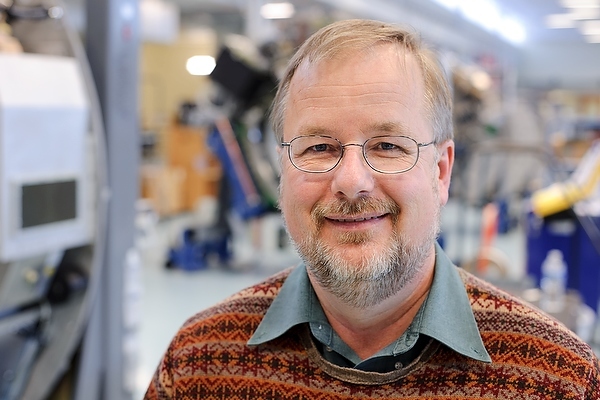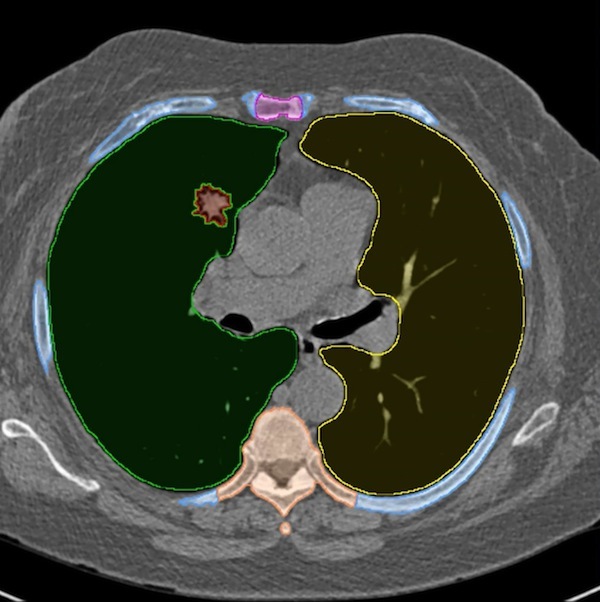Mackie honored as his latest startup shifts toward high gear

Thomas “Rock” Mackie at TomoTherapy in 2011. TomoTherapy is a cancer treatment technology that delivers a radiation dose with a linear accelerator that is guided by a CT scanner.
Thomas “Rock” Mackie, a scientist, entrepreneur and educator, has been honored with the 2015 Excellence in Entrepreneurial Education award for career-long assistance to students and faculty interested in starting businesses.
Mackie, a professor emeritus of medical physics at the University of Wisconsin–Madison, received the award at the Wisconsin Early Stage Symposium Nov. 5 in Madison.
The award was sponsored by Concordia University and established by the Wisconsin Technology Council. “Rock Mackie’s efforts to build an entrepreneurial culture on the UW–Madison campus extend from its labs and classrooms to his work on successful companies and his advocacy for students and faculty alike,” said council president Tom Still.
Mackie is a serial entrepreneur. HealthMyne, his latest startup, develops software that enables physicians to assess and compare 3-D medical images while examining related information from electronic medical records.
The system is being tested at the UW Carbone Cancer Center and the H. Lee Moffitt Cancer Center & Research Institute in Tampa, Florida. Moffitt is among the nation’s largest cancer centers.
By integrating images such as computer tomography (CT) and magnetic resonance (MRI) scans with electronic medical records, HealthMyne gives clinicians a much deeper degree of information, says Mackie, HealthMyne’s chairman.

HealthMyne’s software can automatically identify and outline normal structures, such as these lungs (outlined in yellow and green). A second suspected tumor is outlined inside the left lung in green and red. The sternum has also been automatically delineated (magenta).
Image: HealthMyne
Although HealthMyne offers greater analytic capacity, clinical decisions such as a diagnosis or planning the best treatment will remain the physician’s responsibility; they will not be automated.
The record of achievement for HealthMyne’s leadership team includes the Pinnacle 3 treatment planning system. Now owned by Philips, Pinnacle was the first use of 3-D geometry for accurately planning radiation treatment for cancer. For the first time, the shape of each radiation beam was based on its own unique 3-D view of the volume to be treated rather than a 2-D slice.
The advantage was simple: greater efficacy with less damage to healthy tissue. “Pinnacle is the most widely used radiation therapy treatment planning system in the world,” says Mackie, who is also an emeritus investigator at the Morgridge Institute for Research on the UW–Madison campus.
Mackie and his colleagues also started TomoTherapy, Inc. TomoTherapy is a cancer-treatment technology that delivers a radiation dose with a linear accelerator that is guided by a CT scanner. Although the business was sold for $277 million to the California firm Accuray in 2011, the systems are still made at a factory just blocks from HealthMyne’s offices in Madison.
HealthMyne has 23 employees.
The company’s “light-bulb moment” occurred three years ago, when the discussion at a birthday party among Mackie and his associates turned to the next venture. “We understand imaging and oncology,” says co-founder and CEO Praveen Sinha, “and there’s been a lot of research in academia and cancer centers to make images more useful to clinicians. So we thought, ‘Where can we make the biggest impact in patient care?'”
“The goal was to extract this information and make the system smarter, to provide data analytics that can improve diagnosis, and aid decisions on treatment and follow-up.”
Thomas “Rock” Mackie
In the 1990s, Sinha was a clinical medical physicist at UW Hospital and Clinics.
In cancer treatment, images are used for initial diagnosis and tracking patient progress, Mackie says. “There is a lot of useful information in the images, and the goal was to extract this information and make the system smarter, to provide data analytics that can improve diagnosis, and aid decisions on treatment and follow-up.”
Comparing scans taken at different times is a standard way to assess whether treatment is working, Mackie says. “Today, a physician who is looking at a scan can look at previous scans, but they may have to find them. Our tool offers simple access, and is linked to the patient’s history through the electronic medical record. That combination brings a new level of information and support to the clinician.”
Providing past scans is a relatively simple matter of file management. But HealthMyne is built to get smarter with use, so physicians can get immediate answers to pressing questions. “We can compare you to a similar group of patients,” says co-founder and chief technical officer Roger Chylla, a former staff scientist at UW–Madison. “If you are taking cancer drug X, how does your progress compare to the last 100 patients treated with drug X at our clinic network?”
Such a comparison, Chylla notes, “is usually done only in clinical trials, but they are expensive, lengthy and rare.”
Chylla adds that HealthMyne software could aid in cancer screening.”You want a ‘yes’ or ‘no,’ not a ‘maybe.'” Helping the radiologist record the shape, texture, size and cell density of hundreds of tumors and combine that with electronic medical records, could reduce screening errors.
After its beta system finishes testing, HealthMyne plans to market it to large cancer centers.
Anticipating the future has proven profitable for Mackie and his associates. “Everybody was doing 2-D treatment planning back in the 1990s, and we thought in 10 years they would be doing 3-D, and the adoption of Pinnacle proved us right. The same thing happened with TomoTherapy, which was one of the first to guide radiation therapy with CT scans.”
Ten years from now, Mackie predicts, “most radiologists will be using quantitative imaging, and they will need tools like ours to incorporate electronic medical record data in planning and evaluating treatment.”




